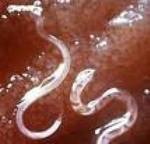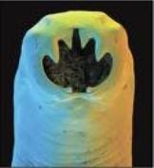AMERICAN HOOKWARM
Under the general title there is a disease caused by two species of nematodes: krivogolovka duodenum and American hookworm - similar in structure, life cycle and impact on the human body.
Hookworm found predominantly in southern Europe (Italy, Portugal), in Southeast Asia; necatoriasis - in East Africa, South America, Azerbaijan, Georgia and Turkmenistan. Infection usually occurs from March to October.
Sources: The source of infestation hookworm are sick people, dogs and cats. The natural susceptibility of people is high. Endemic foci are formed in coal mines and mining at a high ambient temperature, humidity and poor sanitary condition. Risk groups include miners, farm workers, gardeners.
Modes of transmission: The mechanism of contamination - fecal-oral contact and. Most often, infection occurs when a person walks the earth with bare feet or lying on the ground, as well as work with the soil through the skin. The larvae of hookworms are patiently waiting in the wings, tread on them bare foot, and immediately introduced into the body through the pores of the skin. Also, hookworm infection is possible through the use of contaminated vegetables, fruits and herbs. Dangerous to those around a sick person or animal is 8-10 weeks after infection, when mature eggs are beginning to stand out from their body Ancylostoma with feces.
Form of existence: life cycle of hookworms begins with getting the eggs in the soil with feces. Further development of the parasite at a temperature of 28-30 C. Larvae actively promoted in the soil in the horizontal and vertical directions. In contact with human skin soil larva, attracted by body heat, actively penetrates the host through the skin. Then, the larvae penetrate the hookworm blood vessels and move through them in the right atrium, then into the pulmonary artery and pulmonary capillaries into the alveoli. Breaking the walls of capillaries, they enter directly into the alveoli, and then penetrate the airway in the throat. With saliva larvae ingested host and fall within the intestine. With food parasites go down the gastro-intestinal tract, where their journey ends at last - adult parasites mature in the small intestine, where hookworms can live up to 6 years. Made their larvae go out with the faeces.
Symptoms of the disease: The incubation period is 40-60 days. Symptoms depend on how the penetration of the parasite in the body. In most cases, the number of penetrating into the body of parasites is low, and therefore the disease is asymptomatic. When the larvae penetrate the skin ankilomostomoz proceeds with allergic manifestations: skin itching, rashes of various kinds against the backdrop of pale skin (usually on the legs) that persist for several months. Massive infestation leads to edema of the extremities. When the larvae migrate through the respiratory tract may be catarrhal phenomena appear dyspnea, catarrh, hoarseness, developing bronchitis, pneumonia, pleurisy. At a later stage, when released into the gastrointestinal tract, developed duodenitis with nausea, heartburn, abdominal pain, often accompanied by diarrhea.
Consequences of getting parasited: Chronic hookworm infection is manifested by weakness, dizziness, pain in the epigastrium, weight loss, edema. Since hookworm feeds on the blood, it attaches to the teeth mucosa of the intestinal wall, where the formation of bleeding ulcers, reaching 2 cm in diameter. Due to chronic blood loss develops hypochromic iron deficiency anemia, decreased white blood (hypoalbuminemia). Affects the central nervous system, there is a lethargy, retarded mental and physical development. In severe cases, may lead to death.
Methods of diagnosis: Diagnose hookworm in laboratory evaluation for the detection of parasite eggs in faeces.


